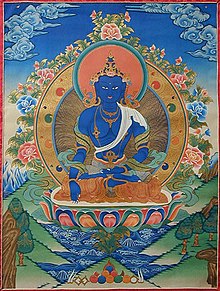
Back Акшобхя Bulgarian অক্ষোভ্য Bengali/Bangla མི་འཁྲུགས་པ། Tibetan Akshobhya Catalan Akšóbhja Czech Adibuddha#Akshobhya German Budho Akŝobjo Esperanto Akshobhia Spanish Akšobhja Estonian اکشوبهیه Persian
| Akṣobhya | |
|---|---|
 | |
| Sanskrit | अक्षोभ्य
Akṣobhya |
| Chinese | 阿閦佛
(Pinyin: Āchù Fó) |
| Japanese | 阿閦仏
(romaji: Ashuku Butsu) |
| Khmer | អសុភ្យ (a-sop), អសុភ្យពុទ្ធ |
| Korean | 아촉불
(RR: Achog Bul) |
| Mongolian | ᠬᠥᠳᠡᠯᠦᠰᠢ ᠦᠭᠡᠢ Хөдөлшгүй SASM/GNC: Ködelüsi ügei |
| Thai | พระอักโษภยพุทธะ |
| Tibetan | མི་བསྐྱོད་པ་ Wylie: mi bskyod pa THL: mikyöpa |
| Vietnamese | A Súc Bệ Phật, Bất Động Phật |
| Information | |
| Venerated by | Mahāyāna, Vajrayāna |


| Part of a series on |
| Buddhism |
|---|
 |
Akshobhya (Sanskrit: अक्षोभ्य, Akṣobhya, "Immovable One"; traditional Chinese: 阿閦如来; ; pinyin: Āchùrúlái; Japanese pronunciation: Ashuku Nyorai) is one of the Five Wisdom Buddhas, a product of the Adibuddha, who represents consciousness as an aspect of reality. By convention he is located in the east of the Diamond Realm and is the lord of the Eastern Pure Land Abhirati ('The Joyous'). His consort is Lochanā and he is normally accompanied by two elephants. His color is blue-black and his attributes include a bell, three robes, and staff, as well as a jewel, lotus, prayer wheel, and sword. He has several emanations.
